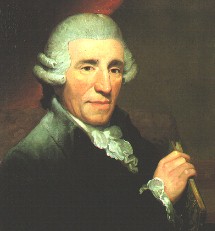The composer Franz
Josef Haydn was born on this date in 1732. Here are ten facts you may not know about him:
- Franz Josef Haydn is nicknamed "Father of the Symphony" and "Father of the String Quartet".
- Neither of his parents could read Music, but they were a musical family and soon recognised that their son had a gift. They sent him away at the age of six to Johann Matthias Frankh, the schoolmaster and choirmaster in Hainburg so that he'd get proper musical training. He wasn't well cared for there - he was often hungry and had shabby clothes. However, it was during his time here that Georg von Reutter, the director of music in St. Stephen's Cathedral in Vienna, was looking for new choirboys, and happened to hear him sing.
- He sang in the choir for some years but was eventually thrown out when his voice changed and his inability to sing the high notes drew complaints from high places - Empress Maria Theresa complained about his singing, calling it "crowing". Around this time, he cut off another chorister's pigtail as a joke, which was the final straw. He was caned and dismissed. It could have been worse - it had been suggested by the choirmaster that Haydn should have a certain operation to stop his voice from changing, but his father intervened and the composer remained intact.
- He married Maria Anna Theresia Keller the sister of Therese, with whom Haydn had previously been in love. It wasn't a happy marriage, and since divorce wasn't an option for them, they both took lovers.
- Haydn spent much of his career as a court musician for the wealthy Esterházy family at their remote estate. This isolated him from the current musical trends of the time, and as he put it himself, he was "forced to become original".
- Haydn's solution for composer's block, as a devout Catholic, was to say the Rosary. He began the manuscript of each composition with "in nomine Domini" ("in the name of the Lord") and ended it with "Laus Deo" ("praise be to God").
- Later in his career, he travelled to London, where he was so inspired by the British National Anthem that he decided to write a piece of patriotic music himself, for Austria. The tune he wrote is now Germany's national anthem.
- Haydn's Symphony no. 96 was nicknamed the 'Miracle' Symphony because a huge chandelier fell from the ceiling during the première, yet nobody was injured.
- Napoleon Bonaparte was a fan of his music, to the extent that when he invaded Vienna in 1809, he placed a guard at the home of the old and frail composer so he would not come to any harm. Haydn died soon afterwards, anyway, from natural causes.
- After he died, graverobbers stole his head. Their motive? An interest in phrenology, the idea that people's personalities and talents can be ascertained by studying the bumps in their Skull. The thieves wanted to see if Haydn's skull had a "bump of music" (their conclusion was that it did). One of the perpetrators, Johann Nepomuk Peter, kept Haydn's skull for some years after that. He kept it in a custom-made black wooden box, with a golden lyre on top, glass windows, and a white cushion. In 1820, Haydn's old patron Prince Nikolaus Esterházy II remembered that he had intended to have Haydn's remains transferred to the family seat in Eisenstadt. The Prince was enraged to discover the skull missing. He had a good idea who might be responsible and he sent his soldiers round to Peter's house to retrieve it. Peter and his wife hid the skull in a mattress, and Mrs. Peter lay on it, claiming to have her period, so the soldiers wouldn't touch it during their search and went home empty-handed. The Prince was later given a different skull and told it was Haydn's, and the other skull was laid to rest with the rest of Haydn's remains. Eventually, Haydn's real skull was reunited with the rest of his body, but the substitute skull was also left in the grave - so Haydn's tomb contains two heads.

No comments:
Post a Comment